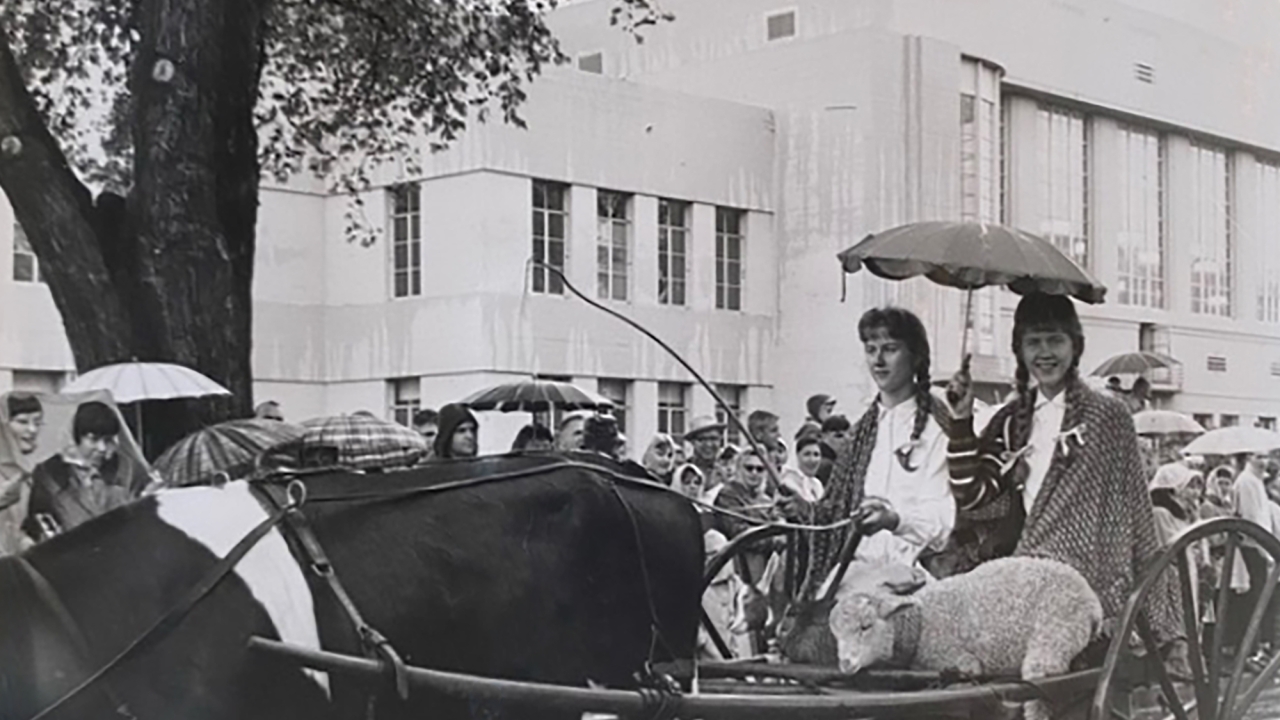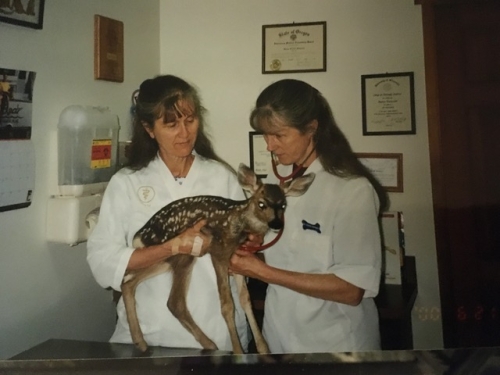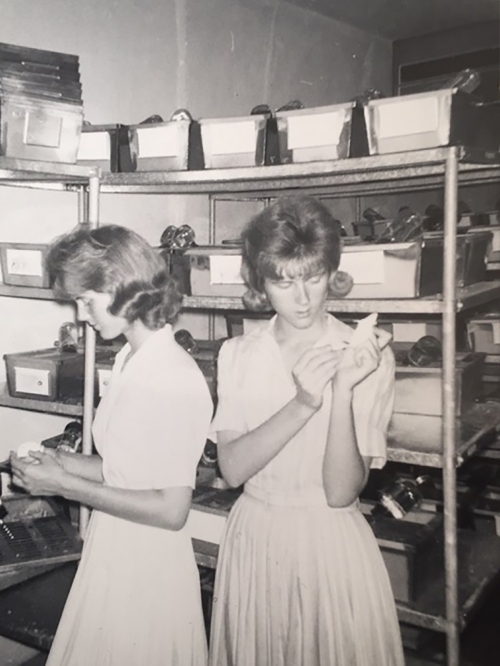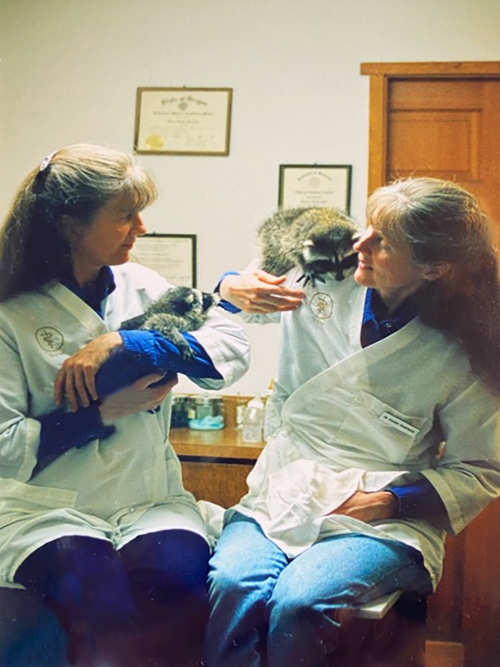
Meet the veterinarian identical twin sisters of Sisters, Oregon
Vet Med alumnae ran practice together for 24 years

From sharing birthdays, earning UC Davis veterinary degrees and running their own practice in an Oregon town called Sisters, Sharon Sharpnack ’65, D.V.M. ’67, and Susan Conner ’65, D.V.M. ’67, have always done everything together.
The retired veterinarians have treated countless species between them: dogs, cats, goats, cows, horses, deer, owls, and even a camel, manatee and crocodile.
“I guess we have the same genes,” Sharpnack joked.
“We’ve always had the same interests and wanted to be veterinarians from the moment we learned what the word meant.”
Growing up in Santa Barbara, the identical twins liked to rescue baby animals — accumulating many pets of their own — and visit the livestock at local farms and ranches.
In junior high, a local veterinarian let them assist around the clinic. This early mentoring experience confirmed that they were just as interested in the medicine as the animals.
“We knew exactly what we were getting into. We just loved every minute of watching surgeries and seeing sick animals treated,” said Conner. “We knew it was what we wanted to do.”
Coming to UC Davis

There was only one place where Sharpnack and Conner wanted to pursue their training: UC Davis, already renowned for veterinary medicine by the 1960s.
Once on campus, the sisters began their journey of becoming veterinarians and lived in the same dorm room. They worked in campus barns, including volunteering at the dairy barn to milk cows, and participated in livestock shows and Picnic Day — where they once drove their trained cow to a cart in the parade.
Most of all, they loved working hands-on with campus’ many and varied animal species.
“We got a wonderful education at UC Davis. We got to have so many experiences with different animals,” said Conner.
One highlight was spending their summers in the cancer research lab of Professor Emeritus Dr. Leslie Faulkin, studying mammary tumors in mice.
“It was fascinating to study the effects of hormones on mice. Much of our time was spent spaying mice, plus removing and transplanting lymph nodes,” said Conner.
It was also a time when far fewer women were enrolled in veterinary medicine programs — including themselves, women only made up 10 of the 48 students in their graduating class.
“I think we all felt like we had to prove something,” said Sharpnack, noting how the challenges began even before college.
“Our counselors in junior high were really discouraging about us becoming veterinarians because it was so difficult back then for women to get into that career,” she said. “I’m glad we didn’t listen to them.” In addition to more equity, advances in technology and medicine have helped make the physically demanding aspects of the veterinary field more accessible: “It’s gotten much easier over the years for women or smaller people to handle large animals because the sedation drugs and anesthesia have improved greatly and that’s made a big difference.”
After earning their doctor of veterinary medicine degrees, the sisters went their separate ways for 12 years. Sharpnack went to work at the Berkeley Dog and Cat hospital and later did an internship at the University of Minnesota to work in small animal medicine and surgery. Conner, meanwhile, went to the East Coast and worked mainly with large animals, including horses at racetracks in New Jersey.
We knew exactly what we were getting into. We just loved every minute of watching surgeries and seeing sick animals treated,” said Conner. “We knew it was what we wanted to do.”
Achieving a lifelong dream
The opportunity to buy a veterinary practice in Sisters, Oregon, brought Conner and Sharpnack together again. They moved their families to start a new chapter at the Sisters Veterinary Clinic, which took on a double meaning with them as the owners.
“Having our own practice was one of our main lifelong goals,” said Conner.

Situated at the base of the Three Sisters Mountains, their practice treated many cases of injured wildlife — including birds of prey, racoons, porcupines and red tail hawks — and, as there were no other clinics nearby, often served as an emergency room.
The twins treated all kinds of patients over the years — including the mountain lion cub cast of Disney’s 1987 movie Benji the Hunted, which was filmed in Oregon.
They also delivered llamas at a nearby llama ranch and, one memorable time, Conner examined a newborn camel and its mother there.
“We just loved having our own practice and doing things the way we wanted to,” said Sharpnack. “We had so many interesting cases and since we had the same education we were always good helpers for each other.” Although each sister wore a nametag at the clinic, their clients often mixed them up. Conner recalls having to tell clients, “It was my sister who saw your dog!”
They’ve always been inspired by the people who supported them throughout their careers. Being mentored by a veterinarian at a young age inspired them to start a program at their clinic where high school students could volunteer for school credit.
“We wanted to provide the same experience for any young student interested in science,” said Sharpnack.
Now retired, Sharpnack and Conner own 10-acre farms about 10 miles from each other, and enjoy spending more time with their families — and their horses.
The sisters still feel that their years at UC Davis were some of the best of their lives: they’ve stayed connected to the School of Veterinary Medicine as donors. In 2017, they attended their 50-year class reunion.
“We’re so lucky that we knew what we wanted to do and that we ended up working together in our own practice,” said Sharpnack.
“I would do it all over again,” added Conner.
